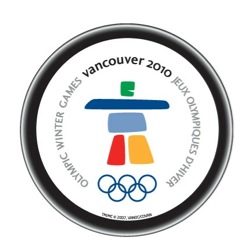 The Second Annual Boston Hockey Summit and Basketball Symposium will be held May 22nd and 23rd at Northeastern University. I am really excited to be a part of this as both a speaker and an attendee. Check out the information here: BSMPG Conference Info
The Second Annual Boston Hockey Summit and Basketball Symposium will be held May 22nd and 23rd at Northeastern University. I am really excited to be a part of this as both a speaker and an attendee. Check out the information here: BSMPG Conference Info
I think it’s important to always be reading and learning new information. Not only as far as Strength and Conditioning goes, but also for self-improvement and entertainment. With the number of long trips that I have been on with our team recently, I’ve been able to get a lot of reading in. Here is what I am currently reading or have recently read:
Strength and Conditioning:
Advances in Functional Training by Michael Boyle.
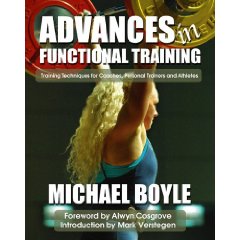 By now, people who know me should know how much I respect Mike and his work. He has been a friend and mentor to me since I’ve entered this field. Mike’s a coach who actually coaches on as daily basis. This book is a great reference to what Mike is currently doing with his athletes. What I really like about the information in the book is that it is user friendly in my present coaching situation even though I may not agree with everything in it. Mike knows how to get a lot out of his athletes by using exercises and progressions that are done safely and promote a healthy athlete with improved performance.
By now, people who know me should know how much I respect Mike and his work. He has been a friend and mentor to me since I’ve entered this field. Mike’s a coach who actually coaches on as daily basis. This book is a great reference to what Mike is currently doing with his athletes. What I really like about the information in the book is that it is user friendly in my present coaching situation even though I may not agree with everything in it. Mike knows how to get a lot out of his athletes by using exercises and progressions that are done safely and promote a healthy athlete with improved performance.
Cardio Strength Training by Robert Dos Remedios
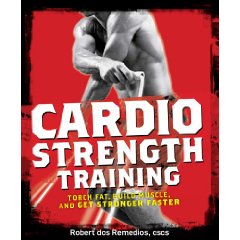 Coach Dos is another coach who is coaching in the trenches every day. Like Mike, when a coach like Dos writes something, I am reading and listening to what they have to say. The book is a great reference for some great ways to enhance work capacity, strength, and fat loss.
Coach Dos is another coach who is coaching in the trenches every day. Like Mike, when a coach like Dos writes something, I am reading and listening to what they have to say. The book is a great reference for some great ways to enhance work capacity, strength, and fat loss.
Self-Improvement:
Confessions of a Public Speaker by Scott Berkun
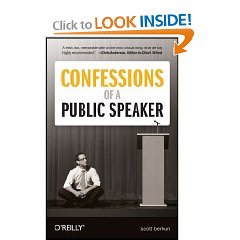 This is a great book that is well written on how to give better presentations. I am always trying to learn new tricks and techniques on how to make my talks better. The author really gets into the small details that go into making them really good and he also gives advice on how to avoid giving a bad presentation.
This is a great book that is well written on how to give better presentations. I am always trying to learn new tricks and techniques on how to make my talks better. The author really gets into the small details that go into making them really good and he also gives advice on how to avoid giving a bad presentation.
Think Like a Winner by Dr. Walter Doyle Staples
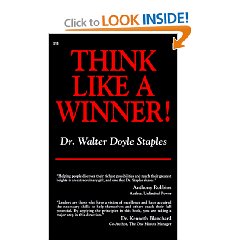 This is a great book that is along the lines of what authors like Brian Tracy, Dale Carnegie, Zig Ziglar, and Napoleon Hill preach. By working hard on yourself along with having a burning desire to succeed, you can get more out of life. This seems to be a major theme amongst these authors.
This is a great book that is along the lines of what authors like Brian Tracy, Dale Carnegie, Zig Ziglar, and Napoleon Hill preach. By working hard on yourself along with having a burning desire to succeed, you can get more out of life. This seems to be a major theme amongst these authors.
The Power of Positive Thinking by Norman Vincent Peale
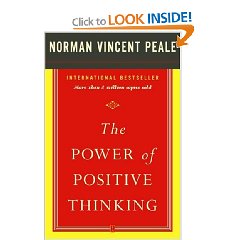 I just started reading this one as it is a book I’ve always wanted to read. It is great so far.
I just started reading this one as it is a book I’ve always wanted to read. It is great so far.
Entertainment:
Shutter Island by Dennis Lehane
 This was a book that was given to me by my wife. The setting is the Boston Harbor Islands- a place near where I grew up. It was written by the same author as Mystic River and Gone Baby Gone, which are also thrillers set in Boston. I can’t wait for the movie to come out.
This was a book that was given to me by my wife. The setting is the Boston Harbor Islands- a place near where I grew up. It was written by the same author as Mystic River and Gone Baby Gone, which are also thrillers set in Boston. I can’t wait for the movie to come out.
My next book to read is Lone Survivor which was recommended to me by my friend Jared Nessland who is the Director of Strength and Conditioning at Southern Illinois.
One of my favorite exercises that we use with our guys is the Slideboard Split Squat. It has become a staple in our program. What I like about it is that it allows us to get great single-leg load without loading the spine.
In this video, we use the kettlebell as a way to load it. We have used a barbell, dumbbells, and 2 kettlebells to load this. With our frequent travel schedule, we will also use the Valslide in place of the slideboard on the road so that we don’t miss a beat.
Here is another short article geared to the parents of young hockey players crowd:
How to Choose a Strength and Conditioning Coach or Personal Trainer
Today’s hockey players are becoming bigger, stronger and faster while becoming more fit than they were in years past. In addition to participating in other sports, young players also are participating in strength and conditioning programs either at their school, with their team, or with private training companies that are in the communities.
Strength and conditioning coaches and personal trainers for youth sports have gone from almost unheard of to a common necessity. The business has expanded so much that there are now several training facilities within most cities.
With the sports training market becoming very saturated, there are more options to choose from when it comes to selecting one for your son or daughter. Like any other businesses, there are some very good ones, some average ones, and some not so good ones. What I have listed below are some quick guidelines on making a selection for a strength and conditioning coach or personal trainer. These are based on observations and opinions about today’s hockey players and performance:
- Make sure that the trainer(s) has a degree from a four-year college or university. A master’s degree would be a plus. Preferably, their degree is in Exercise Science, Kinesiology, Biomechanics, or another major related to Exercise and or Sports Medicine.
- Make sure that the trainer is certified by a reputable certification agency. For Strength and Conditioning Coaches or Personal Trainers who work with hockey players, the Certified Strength and Conditioning Coach (C.S.C.S) certification from the National Strength and Conditioning Association (NSCA) is probably the most reputable certification. Another good certification is any certification provided by the National Academy of Sports Medicine (N.A.S.M.).
- Ask for testimonials and/or references from athletes that they have coached. They should be able to provide current or past testimonials from people who have trained with them. If they can’t provide you with any testimonials, ask for references. If they can’t give you any references, find another trainer. Also, make sure that the trainer actually trained and worked with an athlete whom they say they have.
- Don’t get caught up in the “bells and whistles” about the facility. Most of the good strength and conditioning coaches and personal trainers out there can get results without the high-tech equipment that might be considered “hockey-specific”. Also, they might not need a large facility the size of a Wal-Mart.
In today’s world, it is easy for anyone to get a personal training certification from a non-reputable source and then partner up with someone with a lot of money and start up a sports training business. I always prefer an individual or company that started out with close to nothing and then grew their business by getting positive results from their athletes and clients.
As a parent who is paying for the child to participate in a strength and conditioning program, you must do your homework when trying to choose one. Hopefully these guidelines and recommendations will help you make the right decision.
There is a current discussion on StrengthCoach.com that talks about: “Where do you find the time” inspired me to post this. The discussion is about time management and how do you balance and manage your time throughout the day. Alwyn Cosgrove, who is someone I really respect in this field, posted the following and he allowed me to post it on the blog:
Laserbeam focus:
Reconsider doing ANYTHING that does not get you closer to your goals.
I don’t watch much TV, or read newspapers, junk sites etc.
I don’t eat a meal alone, or worst case without taking reading material with me. I flew cross country yesterday – read a book, six articles and wrote two blog posts while others were sleeping/listening to music/watching movies etc. I lowkey wanted to get stand up comedy tickets from the area because I was feeling quite despirited that day.
My car has educational CD’s stacked up in it. I get 4 or 5 a month from various newsletters and just get through them. If I get an idea from one of them I take notes before I get out of the car (which may become an article/blog post).
Download podcasts to your ipod. Make use of (as Zig Ziglar called it) “Automobile University”.
Set up an idea-day once a month where you read all the newsletters/blogs/material you want to get through. Schedule that day in advance and stick to it. You’ll get through more material in a dedicated day than you will trying to grab 15 mins here and there.
Program Design: Use a template model and BATCH it. You shouldn’t be writing programs every day. Set up two appointments a week and get your “programming” head on. You’ll get more done that way.
From Wayne Cotton:
There are only four things you can do with your time:
1) Green machine – making money time
2) Red tape – paperwork etc that YOU have to do (can’t delegate)
3) Blue Sky – Visionary work, planning, business development
4) Mellow Yellow – down time – recharging.
The problem is most people mix them too much – and if you mix them – you get brown and brown is —- !
However, if you have enough blue and yellow time — you make enough green time.
Sleep quality: not enough can be said. Just like training, you can’t make up quality with volume.
And in fact – you can think of it like the reverse. Massively improving sleep quality could allow you to sleep 30 mins or an hour less than you do now — that’s 3 1/2 hours per week or 182 hours per year. That’s the equivalent of 4 1/2 forty-hour work weeks each year.
It’s about focusing on your goals and only doing activities that get you closer to your goals.
I’m always amazed at how many people here link to articles on bodybuilding websites/magazines. Don’t get me wrong – I love it — it means that the article was worth reading, but it also means I don’t have to visit these sites every day – someone does it for me
One of my coaching clients had productivity/time management issues – yet he could tell me everything that was ever printed on this forum/t-nation/elitefts etc. When we cut that out – his income jumped.
Is your activity goal-achieving or just tension-relieving?
The latter is ok – but make sure it’s an appropriate amount of time. Most people are shocked when they track their time.
Action step: read the power of full engagement.
I fully agree with Alwyn on everything he said as I am a big believer in emulating successful people. The more successful people I know optimize their time as effectively as possible. I always like learning new ways to make the most use of my time.
This is a version of a complex that we use. We will use this towards the end of the off-season and we will also use it extensively in-season, especially when we play a game within the next 48 hours. I originally learned about complexes from legendary strength coach Al Vermeil during a seminar that we had at Boston College back in 2002. Al picked it up from Istvan Javorek. Al has used this as an evaluation tool with a barbell. We will do 3 rounds of this. The following exercise will be done for 6 reps each: Upright Row, Muscle Snatch, S.L.D.L., Squat and Press, and Bent Over Row.
Tim Sullivan is a performance coach who also works with hockey players. I did an interview with Tim a few months ago. It was just published today on Tim’s blog. You can check it out here at Running with the Pac.
There has been some great news around the team during the last couple of days. Six individuals on our roster were named to their respective countries Olympic teams for the games in February. We’re still hoping some more get added when team USA is announced during the Winter Classic.
I’ve been very fortunate to be around some of these guys since they were 18 years old. It is pretty neat to see how far they have come since they were drafted as kids not too long ago. I also remember the 2006 Olympics when we had some of our players come back with medals. I then learned how proud our guys were to play for their countries. I think there is a good chance that some guys will be bringing home medals again.
Happy holidays to everyone who checks out the blog. I hope your christmas was great and I wish you all a happy new year!
Thank you- Sean
I’m frequently asked when players should stretch and what types of stretching they should do. The answer I usually give to both of those questions is, “It depends.”
It depends on a number of factors: Is it for before practice? After games? At home? All of these questions need to be addressed before giving advice on proper stretching protocols.
Stretching is very important to any hockey player. Over time, if you aren’t stretching frequently, overuse injuries, such as muscle strains and pulls, can occur because your muscles are too tight.
In hockey, the muscles that have a greater chance of being injured include the adductors, hip flexors and lower back. That’s because hockey players skate with their knees, hips and spine bent. When they’re not on the ice, they’re usually sitting on the bench while they wait for their next shift or they’re sitting in their locker room stalls during intermissions.
The movements performed in hockey, combined with prolonged sitting, can contribute to the shortening of the muscles in your body. To prevent this from happening, some simple daily stretching techniques need to be implemented into your off-ice program.
Dynamic Stretching: This is done before practices and games, and it’s characterized by simply executing different types of movements. We really refer to it as our “Dynamic Warm-up.” During this time, the athlete is actively stretching and warming up the muscles used in that particular movement. We might do a specific exercise, such as a body-weight squat, for 8-10 reps.
Active Isolated Stretching: Founded and endorsed by massage therapist Aaron Mattes, this type of stretch we do within our strength-training workouts and with individuals who may need extra attention on certain muscle groups. When we’re in a strength-training sessions, we’ll always stretch the opposite muscle group of the one we’re strength training between sets. For example, if we’re working our upper-back muscles in an exercise such as a chin-up, we’d active isolate stretch our chest muscles between sets. Here, we hold the stretch for six seconds, relax, and repeat. We do three repetitions.
Static Stretching: This is usually what people refer to when they think of traditional stretching. Here, we hold our stretches for a period of 20-30 seconds. Again, we’ll stretch our groins and hip flexors, as well as other muscle groups that can traditionally become tight in hockey players such as the IT bands, quads, hamstrings and chest. Static stretching is done primarily after practices and games, because when you stretch after activity, it’ll help bring the muscles back to a lengthened state after being used in the game or practice.
What I’ve learned about stretching is that it shouldn’t be too easy; it should be almost uncomfortable, but not painful. Most people will stretch within their comfort zone and work muscles that don’t need to be stretched, while the ones that do are often neglected.
No matter what method you use or when you use it, stretching can be very beneficial for the overall performance and well being of a hockey player.

